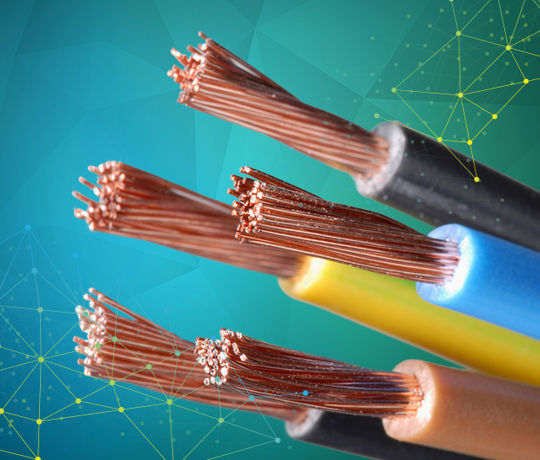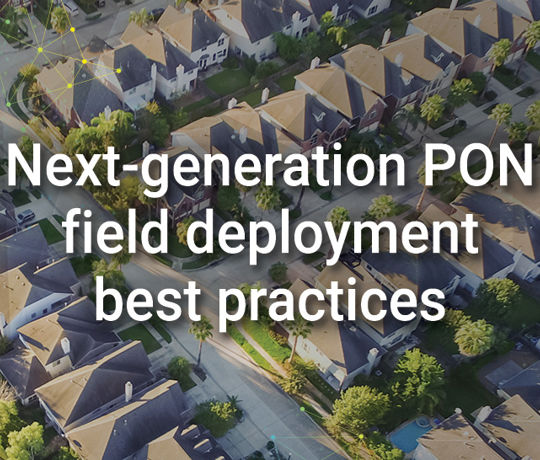Search results
400G transceivers: what’s your game plan? Whether you are equipping data centers to face the bandwidth boom driven by video or prepping your core and interconnect networks for 5G, the move to 400G is unavoidable. When it comes to transceivers, what’s in store as we move to 400G? Is it going to be QSFP-DD or OSFP? CFP8 or COBO? Or maybe all of them? In any case, you need a flexible testing plan in place as transceivers will continue to evolve, that’s guaranteed. This webinar guides you through the exciting changes happening right now in the world of 400G transceivers: Know your basics: wrap-up of the 400G ecosystem Get up to speed: recent innovations in terms of interfaces Pros and cons: deep dive into pluggable technologies (e.g., QSFP-DD, OSFP, CFP8 and COBO) Better safe than sorry: learn how a quick performance check can save you a lot of trouble Testing is more flexible than you think: discover an innovative approach to test 400G networks with multiple transceiver types Leverage EXFO’s expertise in working with NEMs, webscales, CSPs and transceiver manufacturers to get key insights into what lies ahead. Whichever path you choose, you can get there if you have the right support.
ResourcesGfast, VDSL2-35b and future ultra-broadband technologies that utilize existing copper infrastructure will allow service providers to continue to deliver high-speed, highly reliable internet access for many years to come. Managing the copper network and managing the test results will allow service providers to adapt more quickly and more efficiently than ever before. This webinar will provide attendees with the knowledge and tools to continue to leverage and lengthen the life span of their copper networks to satisfy subscriber demand for speed and reliability. The webinar covers all use cases for Gfast, including internet access for residential and business internet access, or for using Gfast for 5G backhaul. Who Should Attend Traditional telcos, including ILECs, CLECs, CSPs and international copper-incumbent entities; competitive national and city operators, especially those with an MDU focus or LLU offering; as well as MDU consultants, building associations, and similar groups of interest. Financial analysts and the media are also encouraged to attend. Key Topics for Discussion Explore market trends around Gfast and ultra-broadband technologies Discuss Gfast and copper loop testing and challenges Investigate automation of field testing for adherence to method and procedures documents Dive into visualization and analysis of field-test results Answers to audience questions during live Q&A
ResourcesAs the 5G race heats up, it is essential for mobile network operators, fixed-line/cable operators, network service providers, and other market leaders to know how to best prepare for the advent of 5G. This webinar explores the challenges and opportunities that the 5G architecture presents and the key test areas and solutions to ensure successful 5G network launches. An expert panel will share important lessons learned in getting networks ready for 5G plus near- and long-term obstacles as our network infrastructure transforms on a fundamental level. Who Should Attend Mobile network operators, fixed-line/cable operators, and network service providers. Telecom/financial analysts and the media are encouraged to attend. Key Topics for Discussion 5G architecture aspects, challenges, and opportunities Key test areas and solutions in 5G preparation Important lessons learned from working with Tier-1 operators Answers to audience questions during live Q&A
ResourcesThis session will explore the current PON technologies being deployed as well as upcoming technologies including XG/XGS-PON, 10G-EPON, NG-PON2 and how you can successfully activate your next-gen customers with first-time-right. Speakers Gwenn Amice, Subject Matter Expert, EXFO Stephen Hardy , Editorial Director and Associate Publisher, Lightwave
ResourcesThis webinar is in Portuguese The OSNR is a fundamental signal quality metric for DWDM networks. Over the years, new technologies such as reconfigurable optical multiplexers (ROADM) and coherent transmission have made traditional methods of measuring the OSNR obsolete. In this webinar, we will first discuss the importance of the OSNR as a system KPI. We will then review existing OSNR measurement methods and why they cannot be used with coherent signals. We will finish by introducing a new method for non-invasively measuring the OSNR of coherent 100G+ signals, EXFO’s breakthrough “In-service Pol-Mux OSNR”. -- A relação sinal-ruído (OSNR) é uma métrica fundamental da qualidade do sinal em redes DWDM. Ao longo dos anos, a adoção de novas tecnologias, como multiplexadores ópticos reconfiguráveis (ROADM) e transmissão coerente, tornou obsoletos os métodos tradicionais de medição de OSNR. Neste webinar, analisaremos primeiro a importância da OSNR como um KPI do sistema. Em seguida, discutiremos os métodos OSNR existentes e por que eles não podem ser usados em sinais coerentes. Para finalizar, introduziremos um novo método para medir de maneira não invasiva o OSNR de sinais 100G+ coerentes, o método revolucionário “OSNR Pol-Mux em serviço” da EXFO.
ResourcesWorking with cabling systems that feature multifiber push-on connectors (MPOs) is a new and potentially challenging endeavor for many technicians. That’s why understanding the importance of MPO connector cleanliness, polarity and continuity, as well as how to test each of these characteristics is crucial to ensuring optimal performance. This webinar will review the basic checks you need to make before turning up MPO-based fiber-optic cabling systems and explore each of the three tests in detail, including the potential risks of omitting any of them.
Resources5G is the buzz. Everyone involved in the large telecommunications ecosystem is developing, trialing, promising and dreaming about 5G networks. While this technology comes with great promises and applications, we seldom hear about the underlying physical network that will have to transport the data to the 5G radios. That’s right, the optical fiber network that has been installed and optimized for other applications (e.g., FTTx, Remote PHY) will now need to reach deeper with possibly more stringent requirements. What does 5G really mean for the network’s fiber foundation? What are the challenges and pitfalls to avoid? How can you make sure your fiber foundation is ready for the next generation of wireless communications? Key takeways: Which fiber architectures will support 5G? What are the new challenges to consider when deploying fiber for 5G networks? What will be the main testing criteria for each part of the 5G optical network? Speakers Jean-Sébastien Tassé, Product Line Manager, Optical Business Unit, EXFO Alan Breznick, Cable/Video Practice Leader, Light Reading
ResourcesThis webinar is in Spanish. La fibra se está haciendo más profunda en todas partes. Es un elemento facilitador clave para las próximas tecnologías 5G que necesitarán una base muy sólida. La alta densidad de despliegues de fibra en el futuro implica una gran cantidad de trabajos de campo subcontratados. El reto que supone la externalización es la reducción de la visibilidad y del control sobre la infraestructura de la red. ¿Cómo se mantendrá al tanto de todo en una época en la que necesita información valiosa para actuar rápidamente? Y esto es solo la punta del iceberg. La elevada rotación de la mano de obra está afectando a los expertos en el terreno. ¿Cómo mantener a los técnicos de primera línea actualizados sobre las recomendaciones necesarias a la hora de realizar pruebas en la fibra óptica? Descubra un nuevo enfoque de las pruebas que permitirá a los técnicos ir más allá al mismo tiempo que garantizan una base de fibra más fiable, y todo eso sin hacer que el banco quiebre, sino todo lo contrario, invirtiendo de forma inteligente en lo que equivale a un menor coste total de la propiedad. En este seminario web, aprenderá a: Acelerar las instalaciones sin comprometer la calidad ni incurrir en costes adicionales Mejorar las habilidades de los técnicos de primera línea y frenar la curva de aprendizaje Acelerar el retorno de la inversión a través de métodos de procedimientos más sencillos Obtenga una visibilidad real de la base de fibra de la red
ResourcesA wide range of solutions has been proposed by the industry to meet these requirements, and as a result, the data center optics market has become increasingly fragmented and challenging to navigate. Supporting all these different reach, form factors, and lane technologies is especially challenging for transceiver vendors as well as test and measurement solution providers. Join EXFO and Fujitsu for this webinar to learn more about: What’s ahead for direct detect and coherent 100GbE, 200GbE, 400GbE, and beyond. How flexible rate transceivers over flex grid networks including ROADMs are being used to economically increase capacity and groom DCI traffic. How flexible test and measurement solutions reduce operational complexity and future-proof capital investments. Who Should Attend DCOs, ICPs, Tier 1 and 2 service providers, cloud service providers, MSOs, government, datacom and DCI transceiver vendors, network equipment manufacturers. Financial analysts and the media are also encouraged to attend. Free Report Everyone who registers for this webinar will receive a special report by Principal Research Analyst Timothy Munks from IHS Markit. A download link will be sent to you and the report will also be available to download from the live webinar console. Key Topics for Discussion Testing and deployment of 400 GbE direct detect 400G ZR, ZR+ and embedded transceivers in DCI networks Flex grid ROADMs in DCI networks How flexible test and measurement solutions reduce operational complexity Answers to audience questions during live Q&A
ResourcesThis webinar will help you keep pace with this shift by unpacking the new vocabulary of digitization: network automation, SDN/NFV, AI, ML/DL, 5G, IoT, SON and other transformative technologies. Learn about market drivers, state-of-the-art solutions and key digital transformation enablers. Understand operator plans, strategies and modern scale-out network architectures to support the transformation of business processes, network operations and ultimately lowering/saving total cost of ownership (TCO). Who Should Attend Service providers, hyper-scalers, enterprises, system integrators, and application developers. Financial analysts and the press are also encouraged to attend. Free Report Everyone who registers for this webinar will receive a special report by Technology Fellow Stéphane Téral. A download link will be sent to you and the report will also be available to download from the live webinar console. Key Topics for Discussion What 5G means for digital transformation The importance and challenges of network virtualization/cloudification How to make the most of analytics and automation in operations and CEM Lessons learned from innovative operators providing network visibility, control and security Answers to audience questions during live Q&A Speakers Stéphane Téral, Technology Fellow, Telecommunications, IHS Markit | Technology, now a part of Informa Tech Murali Gandluru, VP of Product Management, Arrcus Konstantinos Stavropoulos, Ph.D., Solution Marketing Lead, EXFO Allen Tatara, Senior Manager, Webinar Events, IHS Markit | Technology, now a part of Informa Tech (Moderator)
Resources









